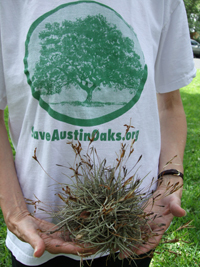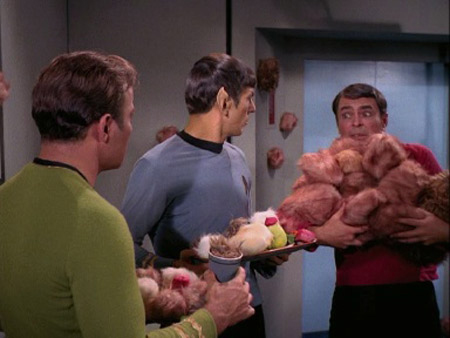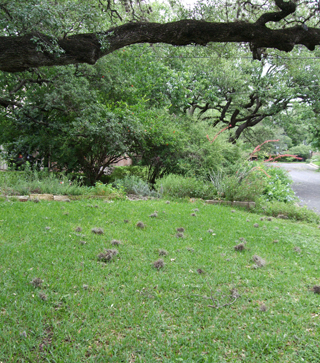Human Flower Project
Thursday, May 15, 2008
Ball Moss ~ Texas Tribbles
A windstorm did what tree pruners couldn’t manage. What to do now with all these nitrogen-rich fashion accessories?
 Oaks are dying in Austin, but don’t blame the ball moss
Oaks are dying in Austin, but don’t blame the ball moss
Photo: Bill Bishop
Last night we were awakened by a rattling of hail. The delight of it turned into a spooky thrum and then the wind began gusting, wildly. We clicked on the TV to hear a jittery weather-caster describing her broadcast building shaking. “I’ve never seen a storm like this,” she exclaimed. And then in a fine burst of unprofessionalism: “My heart is pounding!”
Zap! The power went off. As we went back to bed this speedy storm cell was already moving past. (MSS has more, including photos of broken trees, on Zanthan Gardens.)
Thankfully, our oaks came through intact. And, more to the good, those 70 mph gusts brought down hundreds of ball moss plants. This morning the yard was covered with “Texas Tribbles.”
Many of you will remember these muttering, furry creatures from Star Trek. They came aboard the Enterprise first in 1967, a kind of intergalactic guinea pig, “born pregnant,” as ship’s physician “Bones” McCoy said. They reproduced like crazy, eating the crew’s grain supply, and…well, we won’t ruin the episode for you.

Scotty, ship’s engineer, tells Capt. Kirk and First Officer Spock that Tribbles have overrun the engine room on the USS Enterprise
Photo: via Thorn in Paw
We’ve held ball moss in the same regard as tribbles: harmless, except that too much even of harmless begins to impinge on anyone’s good humor. Having seen many oaks hereabouts with ball moss clotted along dead branches, we feared that in abundance they might be damaging, even killing off, the trees. But how the hell do you get the things down?
 Ball moss (Tillandsia recurvata) downed by an early morning storm, May 15, 2008
Ball moss (Tillandsia recurvata) downed by an early morning storm, May 15, 2008
Photo: Human Flower Project
With 70 mph winds, that’s how. We picked up many hundreds today, some of them obviously in flower.
We’ve since learned that ball moss (Tillandsia recurvata) is an epiphyte, not a parasite. It’s just hanging on to the trees not, like the tribble, stealing moisture or minerals. Betty Rogers and Bill Edelbrock offer a mild-mannered defense of this plant, which many Texans perceive as threatening.
“We notice ballmoss a lot more than the trees do!” they write. “The first few layers of leaves, located at the top foot or two of the tree canopy where they can get full sun, are where the primary growth of trees actually happens. Over 90% of sugars are produced in the top layers of trees. The lower leaves in the shade of the canopy are hanging on for dear life, as insurance in case the upper leaves fall off. Ballmoss is most often found on the dead interior branches of older live oaks. These interior branches die from lack of sunlight – not as a result of ballmoss.” (And, sadly, in our neighborhood, oak wilt is killing many of the trees, noticeably those west of Blunn Creek.)
 Good for summer ear muffs or Princess Leia costumes
Good for summer ear muffs or Princess Leia costumes
Photo: Bill Bishop
Far from being harmful, it seems that Tillandsia recurvata may even pose a benefit to yards and gardens, by “’fixing’ atmospheric nitrogen and adding it to the soil.” So no more pick-ups today. We’ll just mow over the remaining clumps.
At the Garden Bloggers Spring Fling last month, Carol of May Dreams Gardens, a Hoosier, rolled a piece of ball moss in her hand. “In Indiana, people would find a way to do something with these.” Carol, your instincts were right on, as usual. (Congrats, on your all your garden blogging recognition.) If you get here before Tuesday, when the city sanitation guys come, we’ll have bushels of wreath-worthy, nitrogen rich Texas Tribbles for you. We’re dreaming up more ways to use ball moss by the hour.




